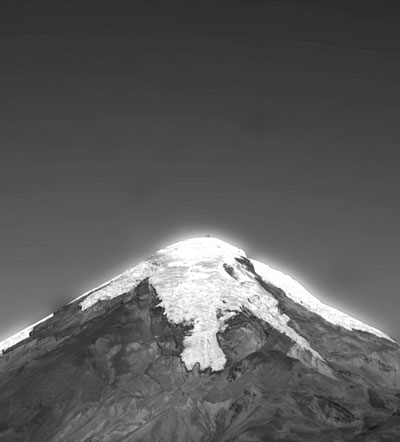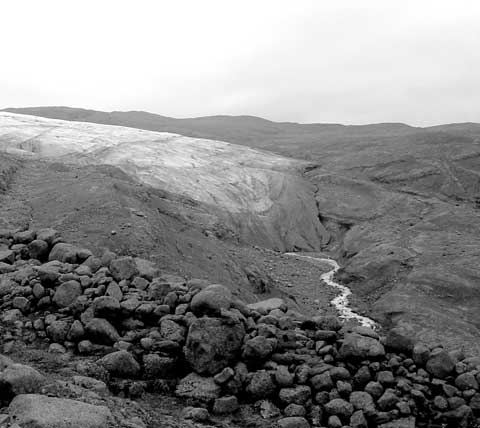Chapter 3
By Eugene F. Provenzo, Jr. and Cory A. Buxton
Climate Change: Glacial Melt & Sea Level Rise

| Florida Sunshine State Standards Benchmark | |
| SC.A. 1.2.2 | Common materials (e.g., water) can be changed from one state to another by heating and cooling. |
|---|---|
| SC.B. 2.2.2 | The student recognizes the costs and risks to society and the environment posed by the use of nonrenewable energy. |
| SC.D. 1.2.5 | Some changes in the Earth’s surface are due to slow processes and some changes are due to rapid processes. |
| SC.H. 2.2.1 | Natural events are often predictable and logical. |
Climate Change and Melting Glaciers

Melting glacier creating streams of water in Iceland, which is east of Greenland.
As you learned in the unit on Earth’s Drinkable Water, about 2% of the Earth’s total water is frozen as ice in the form of glaciers near the North and South Poles. This may not seem like a lot compared to all the water in the oceans, but these glaciers could play an important role in our lives over the next few decades. You have probably heard that climate change is occurring due to mankind’s increased energy use, such as from cars, power plants, and factories.
One effect of the rising temperatures of global climate change is an increased melting of the world’s ice. This melting is most noticeable in the shrinking ice sheets of Greenland and Antarctica. Scientists have been studying this increased loss of glacier ice in recent years, as well as the geologic records of past periods of warming. Both trends have been linked to the fossilized coral reefs found in the Florida Keys. By studying the present and the past, scientists are trying to predict future ice loss and the associated sea level rise.
Video: Museum of Natural History
Watch the short video Melting Ice, Rising Seas.
As you are watching the video, take notes about the methods that the scientists use to formulate and test their hypotheses. Also, try to answer the following questions:
- What evidence do scientists have that the global temperatures are two degrees celsius higher than they were fifty years ago?
- What evidence do scientists have that, in the past, sea levels were higher than they are today?
- What do scientists hypothesize will happen if global temperatures continue to rise?
Activity: Sea Level Rise
In the following activity you will make your own model of the effects of sea level rise on an imaginary island.
Materials Needed
- A plastic “shoe box” size container
- A pound of modeling clay
- A measuring cup
- A ruler
- Water
- Copy of Global Warming Activity Worksheet
To make your model of the effects of sea level rise, follow the steps below:
- Use the modeling clay to form the shape of your island. Consider if it is flat or mountainous. Maybe it has a volcano? Place your clay island in the plastic shoe box. You can decorate your island with small pieces of plants to represent trees, add some sand for the beaches, etc.
- When there is no water in the box, what is the depth of the water? What percentage of the island is covered by water? Using the Global Warming Activity Worksheet, fill in the first row of the data table for 0 cups of water.
- Measure 1 cup of water in the measuring cup and pour it into the box. Use the ruler to measure how deep the water is in the box. Estimate the percentage of the island that is under water. Record the data in Row 2 of the data table for 1 cup of water
- Repeat Step 3 a total of five more times until there are 6 cups of water in the shoe box. For each cup of water added, fill in the next row of the data table.
Exploring One Water
Why is glacial runoff and ice cap melting such a serious issue?
The world’s highest mountains are rapidly losing their snow caps as a result of the climate change.
Have students review the following summary questions:
- Why do you think it rains more in some places than in others?
- Why do you think it often rains more in the summer than in the winter?
- Look at the interactive map of sea level rise. It shows the actual effects of sea level rise from 1-6 meters on coastal areas and islands. How are these maps similar or different from your model island and data table?
Consider the Following Poem
“The River Speaks,”
by Gene Lindberg
(published on the front page of the Denver Post Weekly Magazine - February 5, 1933)
Down from the mountains of eternal snow
The streams come tumbling, joining as they flow
To send a river winding toward the sea.
I listen, and the river speaks to me.
It tells of meadows on a thirsty plain;
Of gardens blooming where there is no rain;
Of mighty cities built upon its banks;
Of living things that owe the river thanks.
The waters speak to me, and hurry on,
Eager to come and eager to be gone.
Almost it seems as if the river knew
How many things there are for it to do.
Sometimes it pauses, to lay up a store
of liquid wealth in lake and reservoir,
Then leaps a dam and hastens on again,
Turning a wheel to light the homes of men.
The river speaks, and deserts cease to be;
Wide fields grow green, and ships go down to the sea,
I hear the water singing as it goes:
“Let life go on, because the river flows.”
Extension Activities
Elementary School Students
The movement of glaciers is similar to that of melting ice cream. Show students how this is the case with the following demonstration.
Materials Needed
- A pint of vanilla ice cream
- Three or four dark sugar cookies (ginger snaps will work well)
- Long narrow pan
- Book about an inch thick
- Serving Spoon
Procedure
- Place the book on a table and use it to prop up one end of the pan.
- Crumble some of the cookies and place them in the top 1⁄4 of the pan. Keep about a 1⁄4 of the cookie crumbs on the side.
- Spread and flatten the ice cream over the cookies.
- Sprinkle some of the cookies a few inches below the ice cream.
- Leave the ice cream to melt.
What will happen
As it melts, the ice cream will carry bits of the cookies down the pan and pick up additional cookie crumbs as it continues to melt. This is similar to what happens when a glacier melts and it pushes stones and earth along with it.
Multimedia
Have students create a stop-action movie of the ice cream “glacier” melting. Have them take a frame every thirty seconds. This can be done with a video camera or with a still camera on a tripod, one picture being taken every thirty seconds.
Middle School Students
What makes a glacier? Where are glaciers found? How does climate affect glaciers? Have students go online and write paragraph-length answers to each of these questions.
Multimedia
Have students make lecture or presentation cards with answers on the back for the questions included above . Have them create four or five additional information cards with a definition of what a glacier is along with images of interesting glaciers . Have them give a presentation using the cards . This can be done individually or as part of a group. Note: This project can also be done using software such as Power Point™, Keynote™, etc.
Secondary School Students
There has been a great deal of controversy over the extent to which Global Warming is actually taking place . At first, many people denied that it was even occurring . While it is now almost universally accepted that Global Warming is underway, many argue that its potential impact is being exaggerated . Divide your class into two groups and have them go online and research the basic arguments for and against global warming . In a debate, have one side of the class defend the position that “Global Warming is Exaggerated as a Problem .” Have the other side take the position that “Global Warming is a Crisis .”
Multimedia
Have students videotape the class’s debate, edit it and post it on the Internet.
